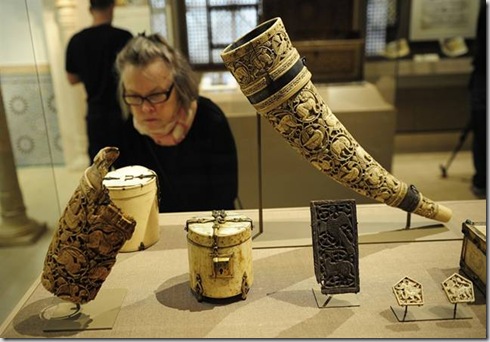THE METROPOLITAN MUSEUM OF ART
New Gallery
Inaugurazione November 01, 2011
Installazione Permanente
15 sale
![clip_image004[4] clip_image004[4]](https://blogger.googleusercontent.com/img/b/R29vZ2xl/AVvXsEgr8VFXg6GLb_dOM6rbgJS2IWa_VuvHFdo-PJkX3zgZp2maTUUkEMC2JSr4r8JvN_iS55Oc2oOVWLVEZNVBiELfBA9DOmXlKISLN_MFPd5_6jgWbZexDjtyXQnuqLDwNSRb1T8HXzgoIW8E/?imgmax=800)
Throne leg, late 7th–early 8th century, probably Western Iran, Bronze; cast around a ceramic core and chased
![clip_image005[4] clip_image005[4]](https://blogger.googleusercontent.com/img/b/R29vZ2xl/AVvXsEjUQlewwlUewx7j2ljTcN7K-6zWZsH61CQZJt43R9qov3IWJhSIS7QPJcVPuBzNjX5U80njvcRFm7Q663m7H6irVStlOfzGxX0xFGpZ6fFOhxt21w-AoELL1WV5hG0PLrkKcR9cRLd1kDEl/?imgmax=800) Non-illustrated manuscript, folio, second half 9th–mid-10th century, Tunisia, probably Qairawan, Gold and silver on indigo-dyed parchment
Non-illustrated manuscript, folio, second half 9th–mid-10th century, Tunisia, probably Qairawan, Gold and silver on indigo-dyed parchment![clip_image007[4] clip_image007[4]](https://blogger.googleusercontent.com/img/b/R29vZ2xl/AVvXsEihS11YLevbgACsR2u0ffofmCzTBKqiqF85yqRaOj9KkHWlKorZBmIgi4j4EwwKf3431c2bQHoUfgRyBZVIyl98BZkZtEfiuGM7G0YrpTflUYp06Psy2ABZ82RYhyphenhyphenk8u1jIr7LjCuK712oI/?imgmax=800) Mosque lamp, ca. 1325, Egypt or Syria, Glass, colorless with brown tinge; blown, folded foot, applied wick holder and handles, enameled and gilded
Mosque lamp, ca. 1325, Egypt or Syria, Glass, colorless with brown tinge; blown, folded foot, applied wick holder and handles, enameled and gilded![clip_image008[4] clip_image008[4]](http://lh3.ggpht.com/-b714Mt7iQCc/TqkoSjhrgWI/AAAAAAAA7Co/owOhvfvOp60/clip_image008%25255B4%25255D_thumb%25255B4%25255D.jpg?imgmax=800) Astrolabe, dated A.H. 690/ A.D. 1291, Yemen, Brass; cast and hammered, pierced, chased, inlaid with silver
Astrolabe, dated A.H. 690/ A.D. 1291, Yemen, Brass; cast and hammered, pierced, chased, inlaid with silver![clip_image009[4] clip_image009[4]](https://blogger.googleusercontent.com/img/b/R29vZ2xl/AVvXsEi2kSO1OgswtEBExcQljmaLuA9DsjMSWIFK6wb2vMwNOi5ahdszu6Yp_Hpzhu_90Ct4VByz7i-f31NxNb6IZaVJCzQkpA_3bsiarJ4ZciXHW5Kd2146j843acuYIjxaZSr9VDwLKFgsum2u/?imgmax=800) Dish, 10th century, present-day Uzbekistan, Samarqand, Earthenware; white slip with polychrome slip decoration under transparent glaze
Dish, 10th century, present-day Uzbekistan, Samarqand, Earthenware; white slip with polychrome slip decoration under transparent glaze![clip_image010[4] clip_image010[4]](https://blogger.googleusercontent.com/img/b/R29vZ2xl/AVvXsEi15m6h4CIwCT4LeJjlV_He9C08JRe975a6MxS0cg2rsqPSDJGB-BtICE66LcFnrAuytx7wiNDyImKCBoDUokWCP6lJZBOPdw4KqFS2V5bi8lxkKSSHgkRBg7ntlWt_AXU4e6sCA7Ywt3b7/?imgmax=800) Tughra (Official Signature) of Sultan Suleiman the Magnificent (r. 1520–66), Turkey, Istanbul, Ink, opaque watercolor, and gold on paper
Tughra (Official Signature) of Sultan Suleiman the Magnificent (r. 1520–66), Turkey, Istanbul, Ink, opaque watercolor, and gold on paper
![clip_image011[4] clip_image011[4]](https://blogger.googleusercontent.com/img/b/R29vZ2xl/AVvXsEhHK6cmd_wemhK9A6PK62_MyWZeVGjVqFB43wAK0GSObq-3z1HNe9t4-rD5s-MYuQXINBSbGR1sRINq0Ru27sf8Nzg7iHPP37g2b9Ts0vd-g7e30acLG-yqNxvYug7SoRbPGRcniS2K6-tE/?imgmax=800) Tile, frieze, late 13th century, Iran, probably Takht-i Sulaiman, Stonepaste; modeled, underglaze-painted in blue and turquoise, luster-painted on opaque white ground
Tile, frieze, late 13th century, Iran, probably Takht-i Sulaiman, Stonepaste; modeled, underglaze-painted in blue and turquoise, luster-painted on opaque white ground
![clip_image013[4] clip_image013[4]](https://blogger.googleusercontent.com/img/b/R29vZ2xl/AVvXsEivxhoA8jJbwSUtXslGHJRtYVKglKPk4nsZWFMvoBAE0sxmswCIERySgGkYFWj3qFpFKAEP5dyarR-xp-s7BVIVPgnAEN6G8iH_MOcjKdFHQdWB1D08n9slIrX2CWh_OFFGds_1MXJb0xS4/?imgmax=800) Carpet, second half 16th century, Iran, Silk (warp and weft), wool (pile); asymmetrically knotted pile
Carpet, second half 16th century, Iran, Silk (warp and weft), wool (pile); asymmetrically knotted pile![clip_image014[4] clip_image014[4]](https://blogger.googleusercontent.com/img/b/R29vZ2xl/AVvXsEgoYFQPOc228vhpZBd4MbXnR4k5BRxBRsYPk2X9NIEMzKf6jCoSfy9z60joC7UVz5LPTqcFuAlZCTCh1cQOeTuaH0PpRr0GiN-MkO5DWRymBmYO-diPIo1cA4c3qRJdJDVnNmUXEcBumsh_/?imgmax=800) Panel, al-Hakam II (961–76), 10th–early 11th century, Spain, probably Cordoba, Ivory; carved, inlaid with stone with traces of pigment
Panel, al-Hakam II (961–76), 10th–early 11th century, Spain, probably Cordoba, Ivory; carved, inlaid with stone with traces of pigment
![clip_image003[4] clip_image003[4]](https://blogger.googleusercontent.com/img/b/R29vZ2xl/AVvXsEif6yvk8qeEk35mhenByMl6UHIGUpgKlAjAa72QZkdBz5s1da-zN7AqTCOaqJ6k43K8-eB42P0EdACdusqBCNOASQBY9nVCNOGV4O7eUphCOqKmRfYqf5z7Ci0ME6DqSCA-OBOwfUEl6XQm/?imgmax=800)
![clip_image006[4] clip_image006[4]](http://lh3.ggpht.com/-2MJ9umSL6kE/TqkoO4POXPI/AAAAAAAA7CI/lJWjzlkBQ_Q/clip_image006%25255B4%25255D_thumb%25255B4%25255D.jpg?imgmax=800)
![clip_image015[4] clip_image015[4]](https://blogger.googleusercontent.com/img/b/R29vZ2xl/AVvXsEjIek-BK-eVAa5TvP1IQb4siix5-V82lgpx2BvVDBOiejYHwc0GWso9Y6Uta6840PvYQknkHuSfkf6oz1r8JQ5bcO_KJGpKeDSIS3NvBeeM1fWRvvTYf55XGE9DxmmdYUv8l4EMG6RFPFsc/?imgmax=800)
![clip_image016[4] clip_image016[4]](https://blogger.googleusercontent.com/img/b/R29vZ2xl/AVvXsEjgZey90Cqbv0N1YnmaCTxWhPZbAnEFWetbfeoMbCt83xPCgr9JmLGUB13NoHvCTXyHysBz-QHXWV2tNLZnbz-6YPouAbE_ADYjvqU3d1HIAvbKWbHh2Xv4-45UuY-Z4wSimoik7e_VpkY/?imgmax=800)
![clip_image017[4] clip_image017[4]](https://blogger.googleusercontent.com/img/b/R29vZ2xl/AVvXsEhm5zJTwgPnbZaaciEayjBTsk3j2BTmZkv5FHS1TwbWdJMlO5BRyNh63Zg1r8MnkTpRJQhvh50VVuiS6VSP3IqRmIGEapbhcnqJgmPZmFwCjsYa2LhasOIm__8Yb1-AcpjG5WEkRA936nzR/?imgmax=800)
![clip_image018[4] clip_image018[4]](https://blogger.googleusercontent.com/img/b/R29vZ2xl/AVvXsEhKsPS6fstUUSLRsv4XCsBYf6GdpIoBa8oz31GjafDE7lRUtWd1GTGdT__KZ7pM69zUW_CZxtt6KONXLHzBkMhca9XmXrcMeM5HJhDKQR8duw69hz3OkqabJJGcBMI4DXQ3IZiTLfS4_E2P/?imgmax=800)

![clip_image003[6] clip_image003[6]](https://blogger.googleusercontent.com/img/b/R29vZ2xl/AVvXsEivXUGPAsuw_qWSqA4yGTMxPvVpzU2AksL4ChQKHj3PaEhJhd1fqSL-Wy5xso-SLTKmOLIGOzJ01j8VFxhiJDqOS7-zdJVoIsjB9KlpSlTKQdG6xng9SYLrJybpMN4kX_mATd7OnhrdwY8/?imgmax=800)
![clip_image005[6] clip_image005[6]](https://blogger.googleusercontent.com/img/b/R29vZ2xl/AVvXsEj7YBzThTND2j49EH4AGiGjm2Fat93BmLM49ejUCdT4ddPMo6nKozIzogylx_mJUKtPBUXwVkJwk3BldKPN6f07TEn-dS-HFsGWQBgzYk5wwNwQs4ynJepJH-b6Yt2u6HJdei6Ej8MQGCj3/?imgmax=800)
![clip_image007[6] clip_image007[6]](http://lh4.ggpht.com/-Z_jyYrsO49I/TqkoxIOyh8I/AAAAAAAA7F8/2nmVoC8aUWc/clip_image007%25255B6%25255D_thumb%25255B3%25255D.jpg?imgmax=800)
![clip_image009[6] clip_image009[6]](https://blogger.googleusercontent.com/img/b/R29vZ2xl/AVvXsEh2OaSpaMjw1PoWXiPsjzuLlmcH9yjCwN1gdcrBK6ZGGeEpV-cjbP-M-MMLtq3TpUtYzETl7vFo2y3qlPTY97itT6BhG0ARmWfWuOJGDyieiL_-QEEz1YvDlr-h4ERzY5_xrGnxHjVNNcII/?imgmax=800)
![clip_image011[6] clip_image011[6]](https://blogger.googleusercontent.com/img/b/R29vZ2xl/AVvXsEjdRBagbTdEnBYEMeJbKf8s1CDiJItfI9H9QmSnx6MfrFKuuyOi6ntZ6y4zMz-dZFIjp-iz3XRdR3pa9yujgAzTMv7M2hbChk_Z2afwPCsh3csrb3v8lUF9R0LINYLxTD_aos-A9tvfUoiO/?imgmax=800)

Nessun commento:
Posta un commento